In February this year, I had the chance to review AusAir’s first foray into masks with the AusAir AirFlex. This mask was one of my most highly requested reviews, and the masks quickly became some of my go-to devices for daily wear. However, while I am a big fan of the AirFlex, it wasn’t a perfect product.
A few months ago, AusAir contacted me again to inform me of their new mask launching – the AirWeave. This mask promises to improve the AirFlex design in many ways, emphasising increasing breathability and comfort.
After reviewing the product description, I found some interesting points that piqued my interest. Firstly, the AirWeave utilises Filtrum’s wool filter. This filter is created in Australia using wool and is some of the most effective natural filter media currently available. Further, it’s highly breathable and significantly more environmentally friendly than polypropylene (which most filters use).
On top of this, the mask is supposedly more comfortable and fits better due to being lighter, using better earloops with an improved fitting mechanism, and allowing for increased airflow. With these improvements, I wanted to determine if the new AirWeave mask is as good as the website implies.
Therefore, today I am bringing you my AusAir AirWeave review. This review will cover the science behind the mask, and I will also share my experiences from wearing the mask for the past two weeks. I will also compare the AirWeave to other reusable masks to help you choose which mask best suits your needs.
As always, if you have tried the mask and have some thoughts and experiences to share, I would love to hear them in the comments below. Further, if you have any questions about the mask, please don’t hesitate to ask on this post. I do my best to reply to every comment!
This post contains affiliate links. For more information, please refer to my affiliate disclaimer. I was sent a product for review, but the article is not sponsored. All opinions expressed in this post are my honest thoughts. I only recommend products that I genuinely believe in.
Information on this blog is for informational purposes only. Readers are encouraged to confirm the information herein with other sources. Furthermore, this information is not intended to replace medical advice from professionals. This website assumes no responsibility for the accuracy of the information, and information is subject to change without notice. Devices mentioned on this website are not medical devices and do not guarantee protection.
Purchase AirWeave and get 15% off with the discount code ‘BSA15’
Filtration

Before diving into the filtration specifications of the Filtrum filter, it’s important to note this filter is a recent addition to AusAir AirWeave masks. When the AirWeave was initially released, the filter media used was the Helix Filter provided by Lanaco. This filter media was fantastic regarding breathability and filtration, but it had some issues with loose fibres that made the mask irritating to wear after the filters were a few days old.
After hearing feedback regarding this issue, AusAir decided to change filter manufacturers. This is a great sign as it shows AusAir cares about customer feedback and is always working to improve its products. While I am a big fan of Lanaco’s filter media in masks such as MEO Face Mask, the Filtrum media works better in the AirWeave.
I wanted to mention this change because if you purchase the AirWeave from a distributor with old stock, you may get the older filters with the mask. Further, if you are reading reviews, it’s important to note that older reviews regarding the filter media may not be relevant anymore as the filter media is now different. If you purchase a mask or filters directly from AusAir, they should all be the newer Filtrum products.
The CAPTURA filters used in the AirWeave are created from merino wool which has the natural property of being the most positive charged electrostatic fibre that exists. This is particularly important because these filters rely heavily on electrostatic filtration to ‘catch’ particles attempting to pass through the filter media.
Another property of these filters is that they are significantly more breathable than similarly capable meltblown and non-woven filters. I will discuss this in more detail in the comfort section of this article. Still, it’s worth introducing here because this is perhaps the most significant benefit of relying on merino wool filters instead of more typical filter media.
So, how does the CAPTURA filter perform when it comes to filtration? Filtrum has submitted filter samples used in the AirWeave to Nelson Labs for the usual three tests – PFE (particle filtration efficiency), BFE (bacterial filtration efficiency), and VFE (viral filtration efficiency). These three tests are the most common for filtration media to undergo.
It is important to remember that these test results apply only to the filter media. These results do not apply to the mask itself but to the tested samples of the filter media. They show the theoretical performance of the mask if both the filter is inserted correctly with no gaps and the mask is adequately worn with no leaks.
If you want to check out the test results for yourself, you can find them on AusAir’s website. The results presented are all from Nelson Labs, one of the world’s leading laboratories for filtration testing. If you’ve ever looked into reusable masks before, you are likely already aware of Nelson Labs, as they test various masks and filters.
Regarding PFE testing, the lowest filtration rating achieved among the tested filter samples was 99.77%. These tests were carried out using a particle size of 0.1μm (100nm) and indicate that the filter can filter a high percentage of ultrafine particles even in the worst-performing sample. On average, the filters had an efficiency of 99.86%
Further PFE testing was carried out at 0.3μm under the same conditions. In this test, the lowest filtration achieved by the CAPTURA filters was 99.921%, with an average filtration efficiency of over 99.95%. Combined with the 0.1μm results, this shows the filter media can filter the vast majority of particles under ASTM F2299 test conditions.
Although these results are impressive, I need to note they aren’t comparable to respirators such as N95s. NIOSH (the institute that approves N95 respirators) has more stringent testing conditions, providing more conservative results than ASTM F2299. NIOSH and other respirator standards also approve the respirator as a whole, rather than just the filter media.
While AusAir and Filtrum’s filtration results are exceptional, this difference needs to be noted as many people compare the filtration results on ASTM F2299-tested masks (most reusable masks) to respirators – unfortunately, it’s not that simple as respirators have more stringent test conditions.
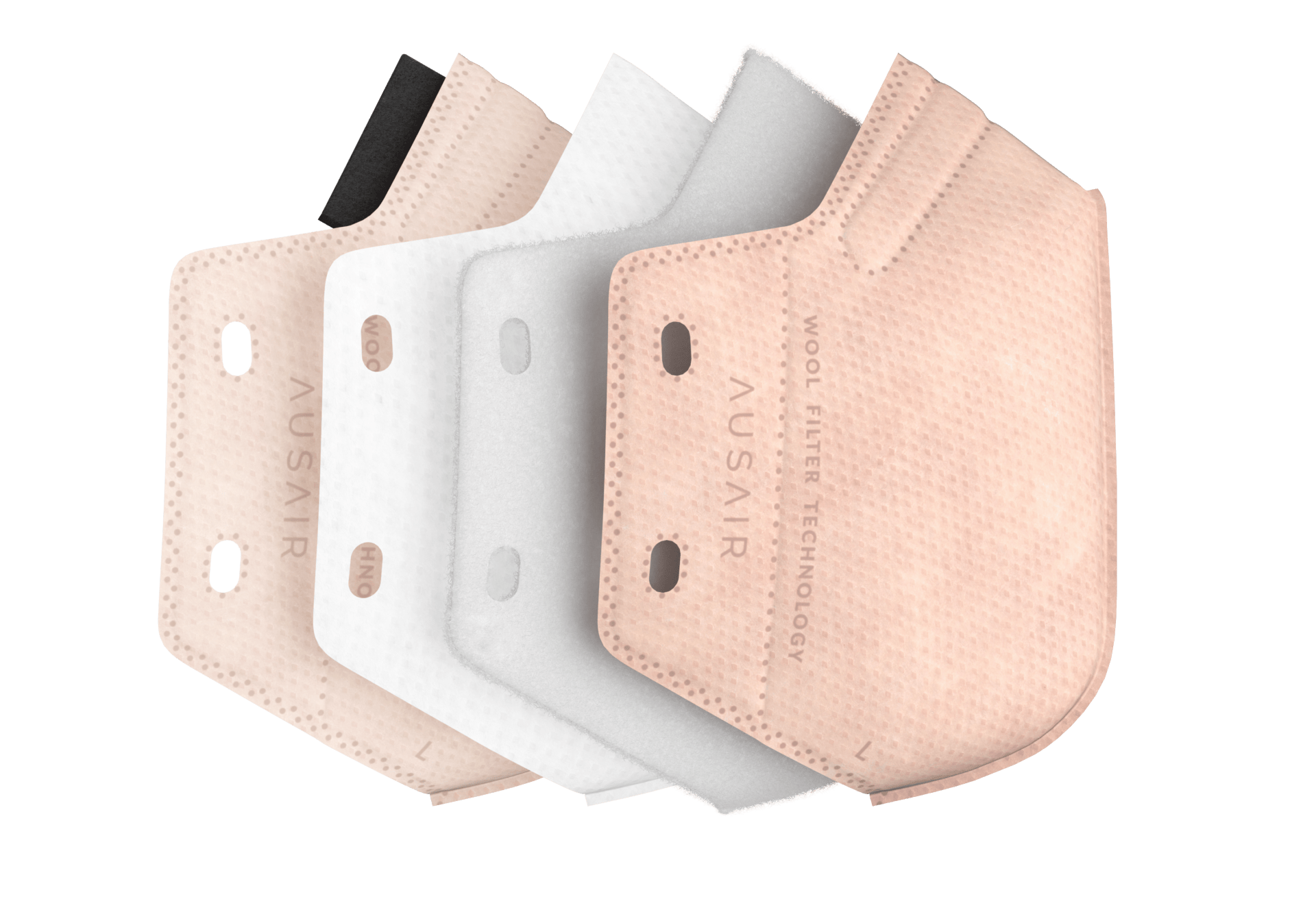
When it comes to BFE and VFE testing, the mean particle size used is 2.8μm and 2.9μm, respectively. These particle sizes aren’t representative of ‘naked’ viral particles but are more akin to the particles that viruses will become attached to. For example, while a specific viral particle could be 100nm in size, they are rarely airborne by themselves and are often attached to much larger particles such as respiratory secretions.
The lowest recorded filtration result for the CAPTURA filter in BFE and VFE was 99.5% and 99.3%, respectively. Interestingly, this means that the VFE and BFE capabilities of the AirWeave are slightly lower than the AirFlex while the PFE capabilities of the AirWeave are marginally better than the AirFlex.
| Mask | PFE | BFE | VFE |
|---|---|---|---|
| AirFlex | ≥99.28% | ≥99.8% | >99.9% |
| AirWeave* | ≥99.921% | ≥99.5% | ≥99.3% |
However, I would still view the AirWeave filter as an improvement in filtration as BFE and VFE tests are less challenging than PFE tests due to the larger particle sizes used. Three samples were tested in both VFE and BFE, and two samples achieved > 99.9% efficiency in both tests. This would indicate the lower results of 99.5% and 99.3% were poorly performing filters, and the average BFE and VFE for the filters are higher.
Another feature that AirWeave has introduced is the addition of copper on the first layer of the filter. This embedded copper layer precedes the CAPTURA filter media and has been tested by Microchem and shown to deactivate > 99.88% of bacteria over 24 hours.
This deactivation period means that if you have multiple filters or AirWeave masks to cycle through, you can rest assured that the filter will remove the vast majority of bacterial particles on the surface over 24 hours. If you plan on doing this, I recommend alternating between three filters.
Overall, the Filtrum filter used in the AirWeave can filter over 99% of the tested particles. However, it’s also important to note that AusAir states the device is meant as a source control device. The mask is currently classified as a reusable community face covering under CWA 17553:202 in the EU and a reusable barrier face covering under ASTM F3502-21 in the U.S.
In real-world usage, the AirWeave is a source control mask that provides some protection to the wearer. However, this mask is not a great choice for air pollution protection or to wear in high-risk situations. In these situations, a disposable respirator or reusable approved respirator such as the Stealth Respirator is a better choice.
Purchase AirWeave and get 15% off with the discount code ‘BSA15’
Fit
While the AirWeave has brought a lot of improvements over the AirFlex, both masks are very similar when it comes to fitting. If you’ve already tried an AirFlex mask, you can expect to find a similar experience here – if the AirFlex fits you well, the AirWeave likely will. Likewise, if you had trouble fitting the AirFlex, you’ll probably also encounter issues here.
The AusAir AirWeave relies on two key features to provide a good fit and to seal the mask. Each filter has a strip of memory foam to help seal the mask around the bridge of the nose, and the mask also features adjustable earloops to adjust the tightness of the mask to your face.
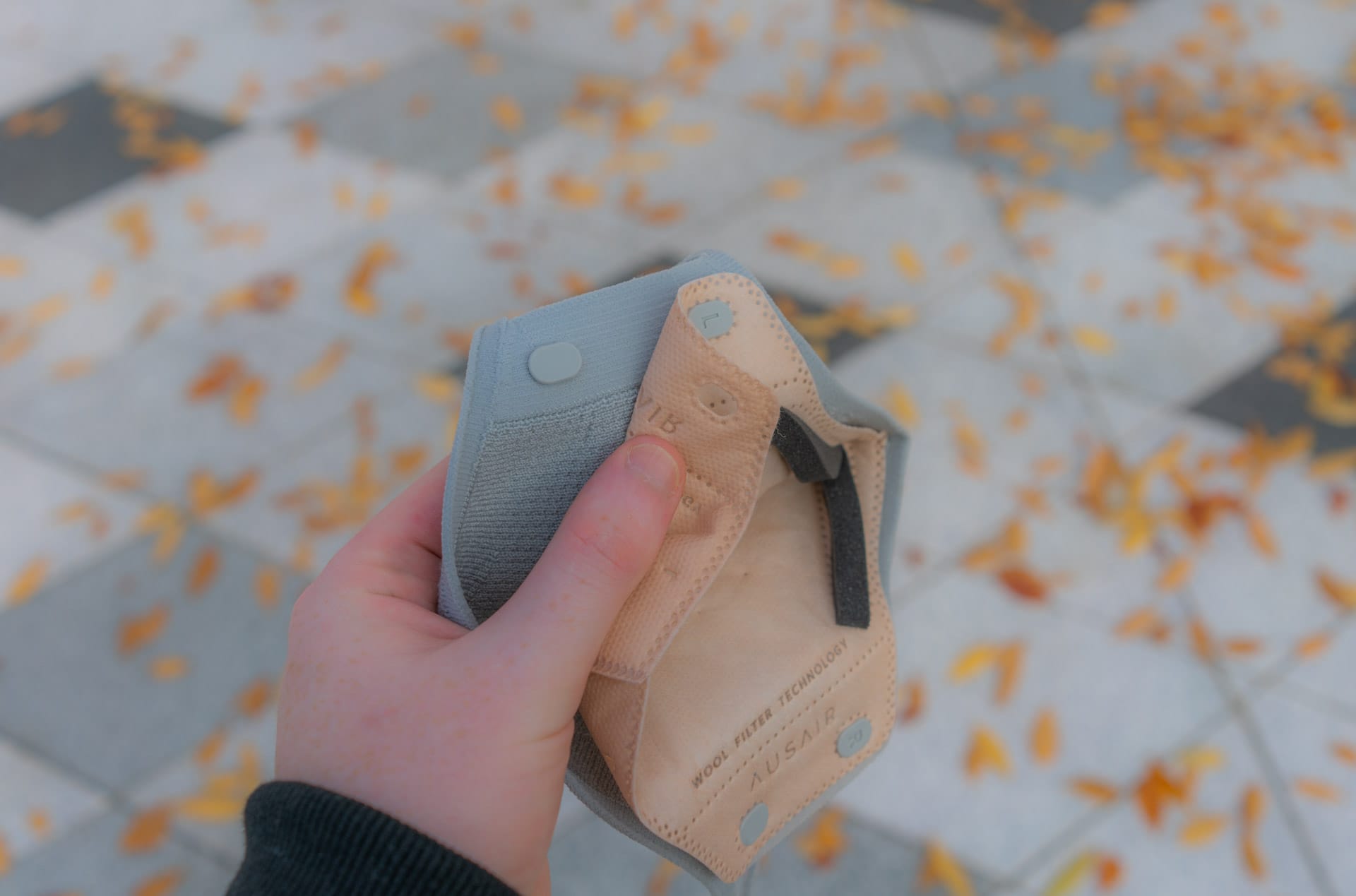
The AirWeave mask is slightly taller than the AirFlex, and rather than allowing the filter to go from one edge of the mask to the other (as on the AirFlex), the AirWeave leaves a small edge around the top and bottom of the filter. I didn’t find this an issue with the mask, as it is along the edges of the filter itself where the seal occurs.
The most significant change when it comes to fit is the redesigned earloop mechanism. One of my issues with the AirFlex was that I would often find the earloop bead loosening over time. This would lead me to need to readjust the mask every few hours.
AirWeave has kept a similar design but has improved it by making it more sturdy. While I would still need to adjust the tightness from time to time, the AirWeave retained its fit significantly better than the AirFlex did.
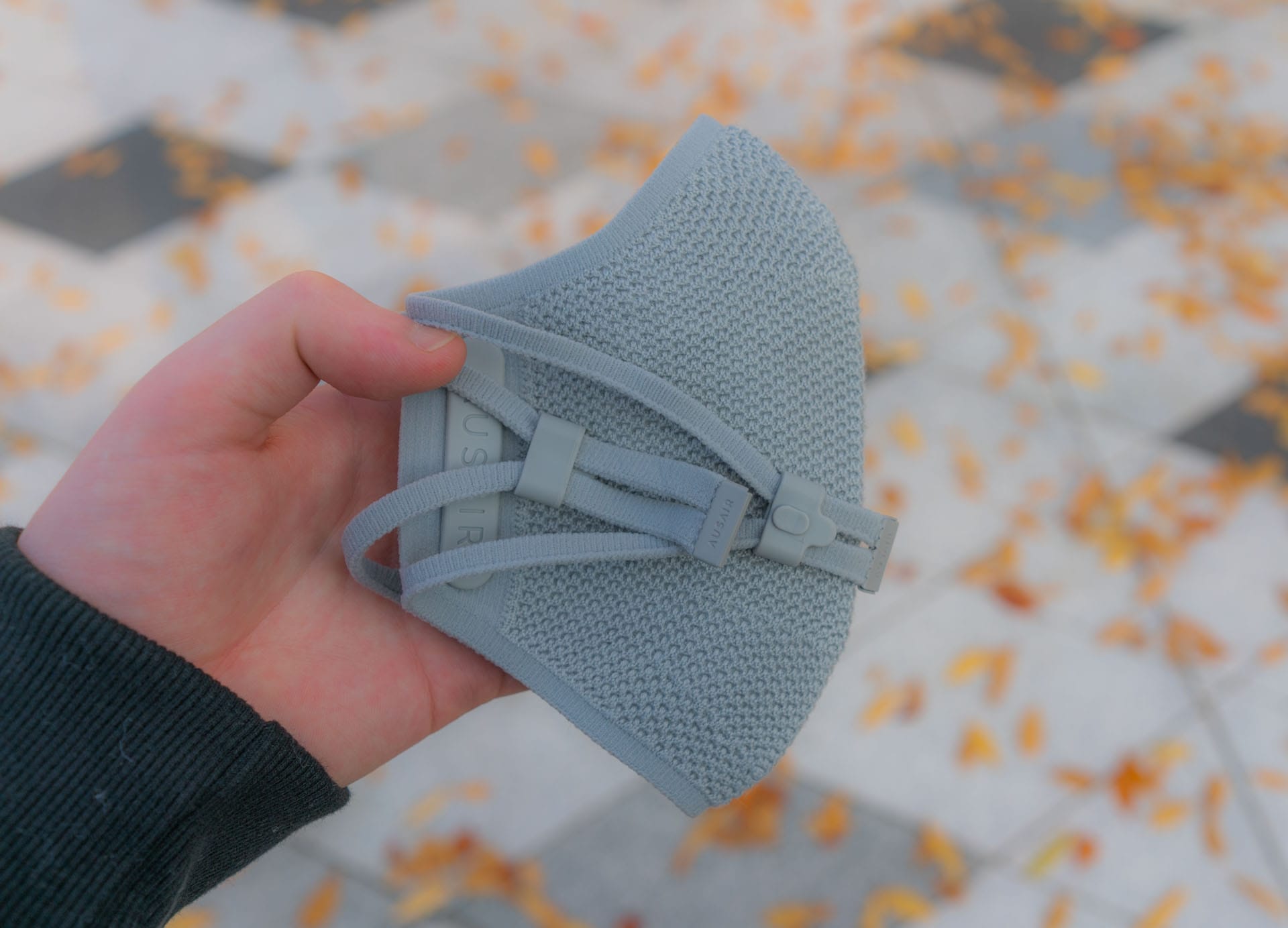
AusAir has also carried over the long memory foam piece integrated into each filter. This memory foam is designed to prevent leakage that often occurs around the bridge of the nose. In addition, this memory foam is contoured to seal comfortable around the wearer’s nose.
Similarly to the AirFlex (with the updated memory foam introduced on later masks), the AirWeave’s memory foam removes the majority of leaks for me. So while I can feel some air escaping when I exhale, I am not worried about this as it’s a common occurrence.
As you exhale, the interior of the mask becomes positively pressurised. This means that the air within the mask is at a higher pressure than the air outside the mask. Due to this, the air within will seek the easiest escape route and will rush out of the mask.
When you breathe in, the opposite happens, and the mask inside becomes negatively pressurised. This leads to the mask collapsing as air from the outside is pulled through the mask and into the wearer’s lungs.

While I experience some air escaping around the top of my nose (which can lead to my glasses fogging up at times), I am also confident that the mask is filtering due to the mask collapsing whenever I inhale. Further, when I tested the mask, I could not detect any major leaks on inhalation.
With that being said, if you are a glasses-wearer like myself, you may have some issues with fogging. At times I could get the mask fitted perfectly, and this issue was non-existent, but other times I struggled to get a fit that would prevent my glasses from fogging up.
As always, these are merely my experiences. I can’t comment on whether or not the mask will fit you as everyone has a different face shape and features. With that being said, the memory foam on the AirWeave does provide a solid fit, and I believe that many people will be able to get a good fit with this mask.
I found that the mask had to be both tightened on the earloops and that it had to sit quite high on my nose for the best fit. The best fit for me occurred when the tip of the mask sat on the same level as the bottom of my irises.
Purchase AirWeave and get 15% off with the discount code ‘BSA15’
Comfort
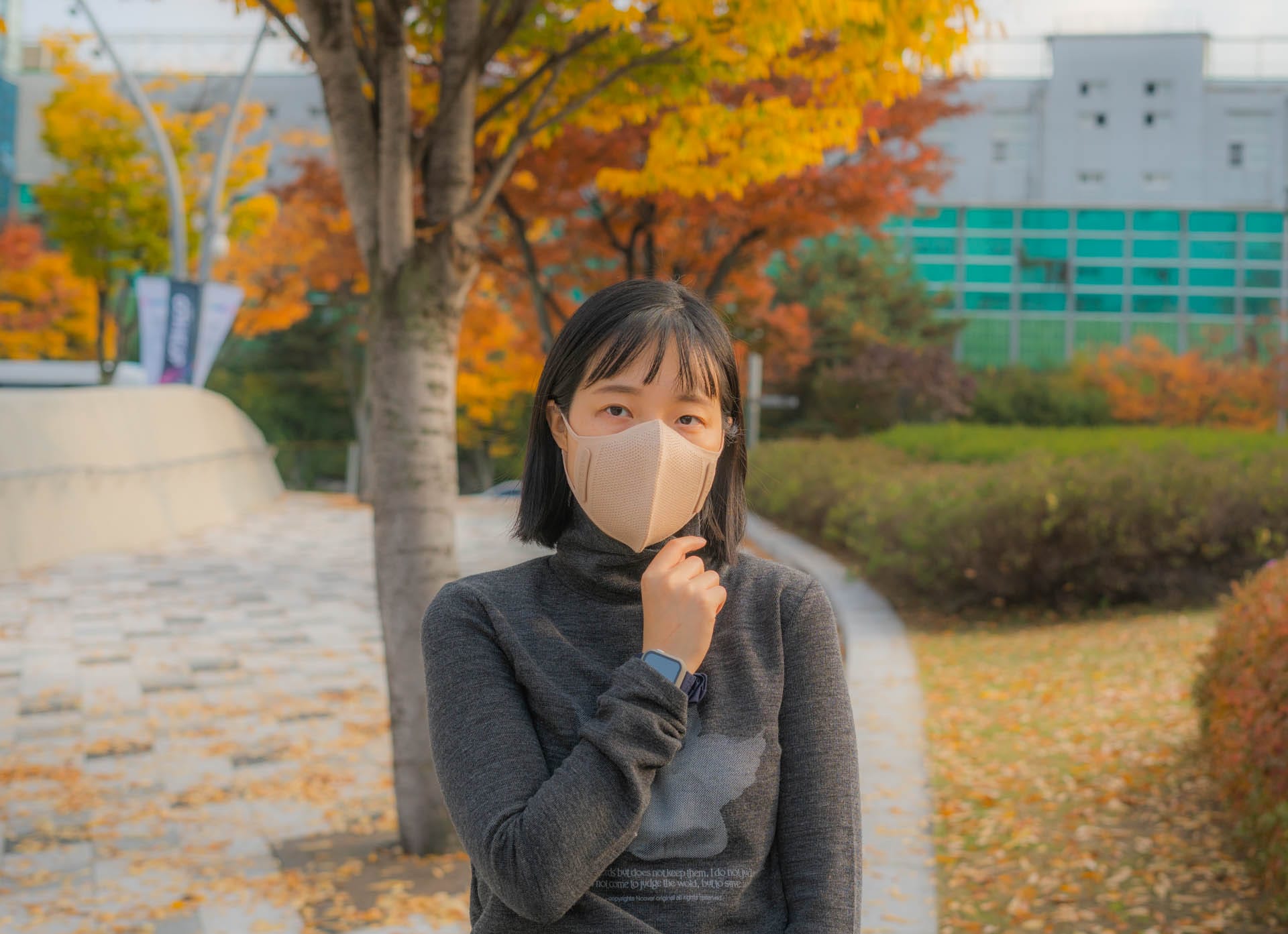
Where the AusAir AirWeave excels is comfort. This is one of the most comfortable masks I have worn over the past year, which has caused me to continue returning to the AirWeave. I have an extensive range of masks I can choose to wear daily, yet this mask has become my go-to mask simply because it’s very comfortable.
The mask that I usually wear daily is from Happy Masks, and I choose to wear it because it is comfortable due to being lightweight and easily breathable. While the AirWeave mask is not quite as comfortable as Happy Masks, it isn’t far behind.
Breathability with the AusAir AirWeave is excellent. The filter is made from wool and specifically designed to be breathable, and the mask’s shell is made from merino wool with gaps to allow for airflow. Despite being a two-layer mask (mask and filter), the AirWeave feels as breathable as many single-layer respirators.
While the filter media itself is breathable, another contributing factor to the breathability of a mask or respirator is the active surface area – the surface area of the filter that is actively filtering. I’ve included two images below showing the difference between filtering surface area in a bifold N95 respirator and the AirWeave.
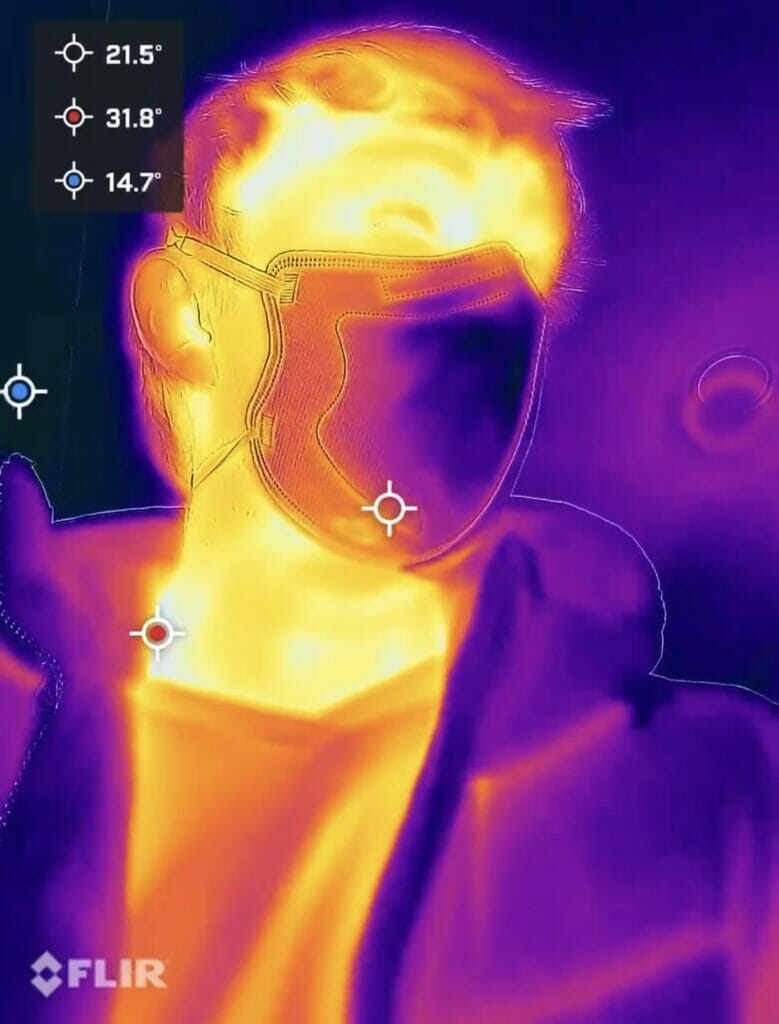

From left: N95 disposable respirator, AirWeave. Images were taken with Flir One Pro.
As the thermal imaging shows, much of the surface area of the N95 respirator in this example isn’t active. Instead, it’s sitting against my face and not allowing air to pass through. On the AirWeave (when fitted as best as I could manage), air passed through a far larger surface area allowing for better breathability.
I would compare the breathability of an AirWeave mask with a CAPTURA filter to a dual-layer nanofibre mask. While I found single-layer nanofibre masks to be slightly more breathable, AirWeave is a close second and is noticeably more breathable than masks that utilise melt-blown filters. Currently, most reusable masks on the market rely on melt-blown filters, which gives AirWeave a big advantage over those masks.
I noticed that the interior of the AirWeave is quite warm. While the mask is designed to remain cool in summer, I found the two wool layers meant that it was always quite warm. During the winter in South Korea, it is often -10 degrees celsius, and the AirWeave mask was very comfortable during the winter months. However, in the summer months (30+ degrees), I sometimes found the mask very warm and uncomfortable.
This is not necessarily the mask’s fault; all masks will have a warm microclimate if worn correctly. However, compared to some other masks on the market, the AirWeave is warmer. Compared to the AirFlex, the AirWeave provides a more balanced microclimate. If you plan to wear the mask in a warm environment, this is something to keep in mind.
The AirWeave does have some filter collapse, and at times, the filter would pull in against my lips. While this wasn’t an issue in most situations, I wouldn’t recommend the mask for exercising. It’s too warm, and the filter collapse is more severe when I’m exerting myself and breathing more heavily.
However, I didn’t find filter collapse to be a big issue when talking or breathing normally. I participate in Toastmasters (a public speaking club) and wore this mask throughout some of my speeches. I had no issue with the mask preventing communication, and it was comfortable to wear throughout.
AirWeave is a significant improvement over AirFlex in regards to comfort. Even with two valves, the AirFlex has more breathing resistance. However, it is worth keeping in mind that the merino wool on the AirWeave is warm and will retain heat more than some masks.
Purchase AirWeave and get 15% off with the discount code ‘BSA15’
Price & Lifespan

The AirWeave Merino Mask is not cheap, and it sells for AUD 89 (about USD 65 at the time of writing). This places the mask securely among the market’s premium segment alongside masks such as Airinum’s Urban Air Mask and Airpop’s Active and Original masks.
This price also means that the AirWeave is sold for an AUD 20 premium over the original AirFlex Mask. Therefore, the AirWeave is not intended to replace the AirFlex, but rather to be an improved mask that sits above it in the AusAir range.
Replacement filters for the AirWeave (AirFlex filters can NOT be used in the AirWeave) cost AUD 25 for a 3-pack. This is the only quantity purchasable, and no discount is offered for larger, bulk purchases. Each filter is rated to last up to 15 days of wear.
I found that this 15-day recommendation is in line with my own findings. Towards the end of this period, the filters became more challenging to breathe through, and some wool fibres began to shed. Thankfully, this is far less of an issue with the updated filters, and since the filters are stated to last around 15 days, I’m okay with shedding beginning to happen around the two-week mark.
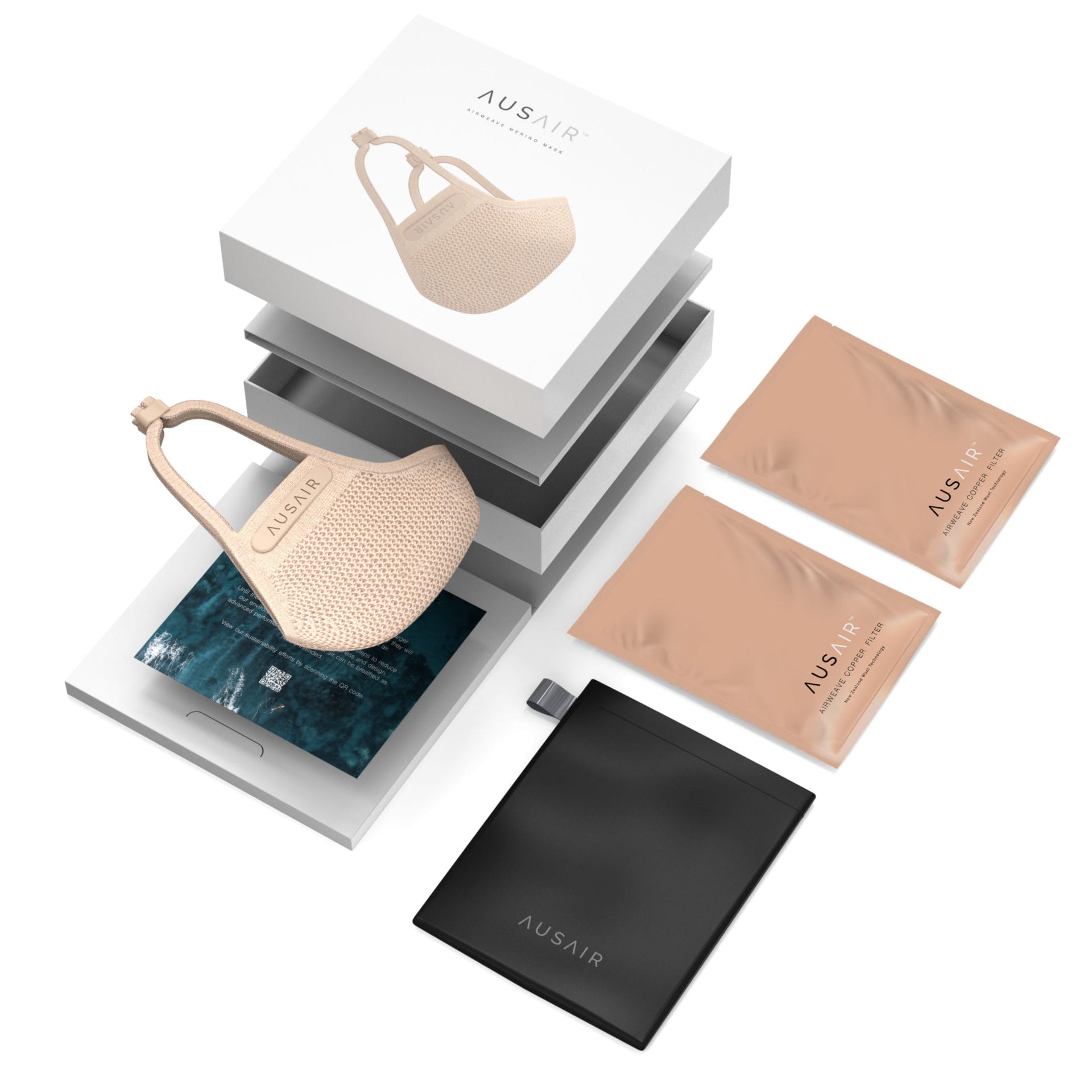
The mask starter kit comes with a few additional items included. You will find a mask, two filters, and one anti-microbial copper-infused carrying bag inside the box. With this starter kit, you can expect to get around one month of usage from the mask.
If you are wearing the mask in locations with high air pollution concentrations, it may be necessary to replace the filter more often for the best performance. However, wearing the mask daily in Seoul for the past two weeks, where the AQI averaged 73, the filter lasted for the recommended lifespan.
Assuming that you can utilise each filter to its maximum recommended usage period, you will get 45 days of usage for each $25 filter replacement pack. This comes to $0.56 per day – much cheaper than relying on disposable masks. But, of course, the initial investment is significantly higher, and it will take some time for the costs to balance out.
A comparable mask, the Bilio Kangaroo Mask, sells replacement three replacement filters for $10 for a 3-pack. While this is cheaper, the filter media is also far smaller, and the increased price on the AusAir mask seems justified.
I would pay the extra $20 to purchase an AirWeave over the AirFlex. While my review of the AirFlex was positive, and I still use it regularly today, there is no denying that the AirWeave brings significant advantages over the previous model.
If you want a more affordable mask, I recommend checking out StyleSeal, the Craft Cadence Nanofibre Mask, and the Honeywell Dual-layer Face Cover. These masks all feature replaceable filters and come in significantly cheaper. In saying that, the AirWeave does have advantages, such as substantially better breathability, that some people will want to pay extra for.
Purchase AirWeave and get 15% off with the discount code ‘BSA15’
AirWeave Vs Other Masks
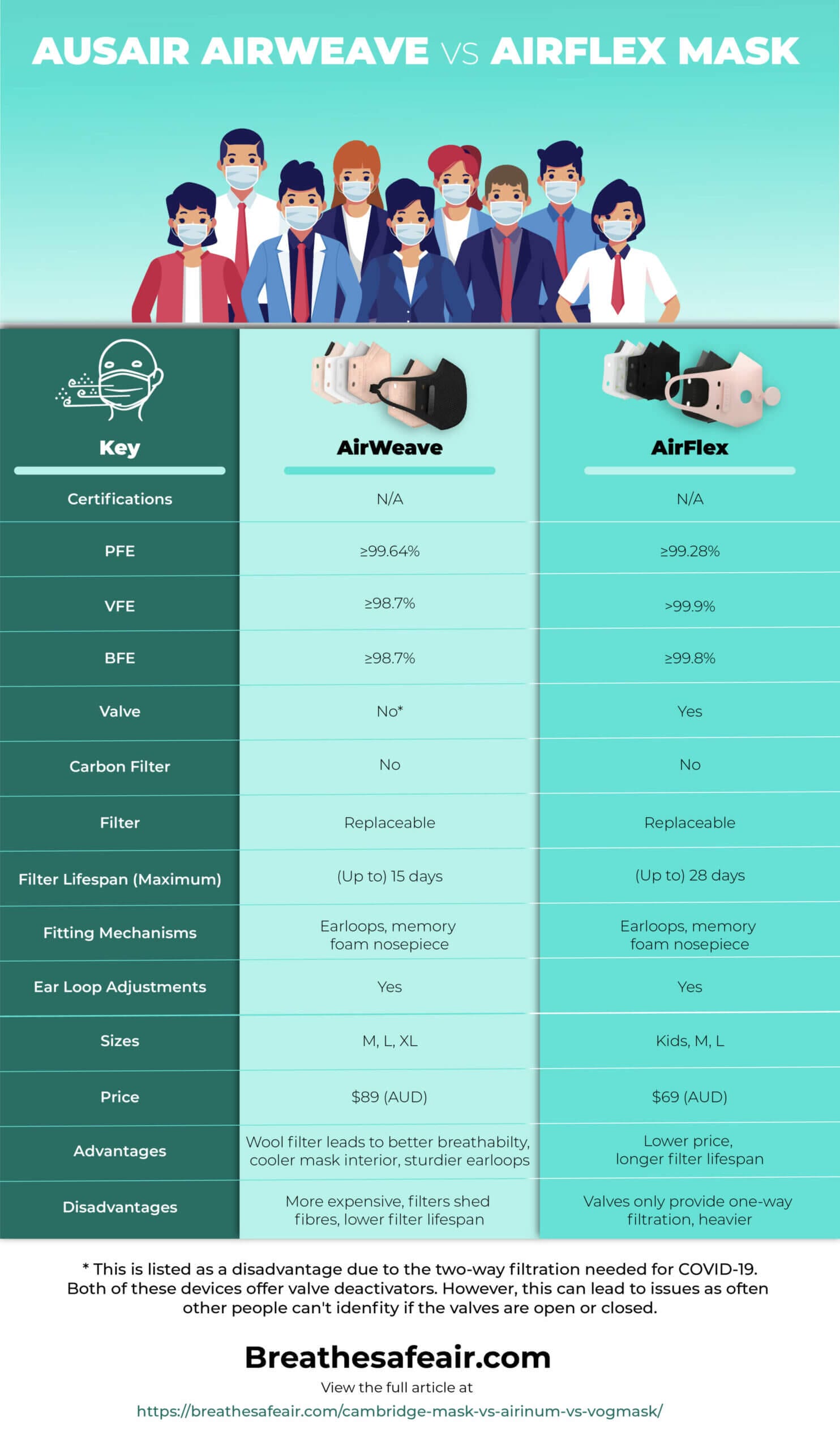
I recently sent out an email newsletter asking readers what they would like to see added to future BreatheSafeAir articles. One suggestion was to add a comparison section to each review. While the current reviews are useful within a vacuum, there are many mask options out there it’s hard to see precisely how masks stack up against each other. If you would like to provide feedback for future articles (and get special deals and more!), you can sign up here.
Therefore, I’ve chosen some masks with similar features to make a comparison. Each of these masks features replaceable filters and is in the market’s more ‘premium’ section. These are the masks that I would deem the main competition to the AusAir AirWeave. I also included Cambridge Mask and Vogmask, as these are the most popular reusable masks despite not having replaceable filters.
| Mask | Filter | Filtration* | Valve | Price |
|---|---|---|---|---|
| AirWeave | Replaceable | > 99.92%** | No | 89 AUD |
| AirFlex | Replaceable | > 99.2% | Yes | 69 AUD |
| Urban Air Mask | Replaceable | > 97% | Yes | 75 USD |
| Airinum Lite | Replaceable | > 94% | No | 49 USD |
| AirPop Active | Replaceable | > 99.2% | No | 59 USD |
| Cambridge Mask Pro | Built-in | > 99.4%** | Yes | 32 USD |
| Vogmask VMC | Built-in | > 95.3%** | No | 33 USD |
Please note that I chose the most similar test results for each comparison. However, some test conditions differ; this is merely a broad overview of each filter’s capabilities. For more details, please check each mask’s individual review.
When it comes to filtration, both AusAir masks perform similarly to the AirPop Active and Cambridge Mask. The other three masks provide significantly less particle filtration. Of course, the fit is equally important and a factor that needs to be considered.
For fit, I would place the AusAir masks, Urban Air Mask, and AirPop Active above the other masks. This is because they all offer adjustable earloops and utilise an additional sealing system – either memory foam or a silicone seal in the case of AirPop.
The fit I can get from these four masks is significantly better than the other three due to these additions. With that in mind, I believe it comes down to the Urban Air Mask, AirWeave, AirFlex, and AirPop Active. Both the Urban Air Mask and AirFlex use valves, yet the AirWeave provides better airflow and breathability. With the new design used in the AirWeave, I can’t see myself recommending the AirFlex.
I’ve found the AirWeave to be more comfortable than the AirPop Active. However, the AirPop Active’s silicone seal does provide a more secure fit, from my experience. The AirWeave also requires less adjusting when donning as the silicone seal on the Active can be hard to position correctly. Therefore, I would recommend reading my AirPop Active review and deciding on a mask from there.
Overall, the AirWeave is a solid mask with no big drawbacks. If you’re looking for a more affordable mask, I recommend checking out this post on the best reusable masks.
Purchase AirWeave and get 15% off with the discount code ‘BSA15’
Final Thoughts

If you’re looking for a community barrier face covering (a source control mask with some level of protection), the AirWeave is an excellent choice. It’s a very comfortable mask to wear, and it excels in being a mask that is easy to wear daily. When going to low and medium-risk areas such as the supermarket, I often wear my AirWeave mask because it’s so easy to wear.
Further, the AirWeave mask is a mask that has outdone the AirFlex in almost every way. As I mentioned in the article, I have always enjoyed AirFlex masks. However, with the AirWeave available, I don’t see when I would recommend the AirFlex anymore, as the AirWeave is just so much better. The primary reason for this is because the AirWeave is more breathable – even though the AirFlex has two valves.
The biggest downside of AirWeave is the price. This is not a cheap mask, and the initial investment is relatively high. Among its competitors, I believe that the AirWeave is the best choice. However, there are more affordable masks that provide some of the benefits.
The second downside is the lack of certifications. While this mask is great for daily activities, you’ll want to look at a certified or approved respirator for high-risk situations or when better protection is needed.
When it comes to a mask with reusable filters, I can’t think of many masks that compare to the AirWeave in this market segment. Airinum’s Urban Air Mask 2.0 exists in the same premium segment; however, I believe the AirWeave is more comfortable and feels higher quality. AirPop’s offerings provide better protection (KN95 with a better seal) but are less comfortable.
Overall, I’ve been impressed with the AusAir AirWeave’s improvements. It’s a solid mask and one that I will be adding to my list of the best reusable masks. So, if you’re looking for the ideal daily mask, I recommend considering the AirWeave!
Purchase AirWeave and get 15% off with the discount code ‘BSA15’
AusAir AirWeave FAQ
Does the AirWeave Mask Have an Official Certification?
No. While the AirWeave’s filter has undergone lab testing, the mask does not have an official certification. However, it is considered a reusable community face covering under CWA 17553:202 in the EU and a reusable barrier face covering under ASTM F3502-21 in the U.S
Does the AirWeave Mask Have Lab Testing?
Yes. The AirWeave’s filter has undergone lab testing for PFE, BFE and VFE.
How Is AirWeave Different from AirFlex?
The AirWeave mask is made out of merino. Combined with the wool filter, this provides superior breathability and comfort. Further, the AirWeave doesn’t utilise valves as the AirFlex does.
Is AirWeave Better Than AirFlex?
From my experience, I would say that the AirWeave is a big improvement over the AirFlex. Especially in regards to breathability.
What Alternative Are There to AirWeave?
If you are looking for alternative masks, I recommend reading this post on reusable masks.
How Much Does AirWeave Cost?
AirWeave costs 89 AUD (around 65 USD at the time of writing).
Have Questions or Comments?
Join the discussion on the BreatheSafeAir Community Forum. Ask any questions you have about air quality or adjacent topics and get quick answers!
AusAir AirWeave

AusAir's AirWeave mask is designed to be the successor to the already good AirFlex mask. However, has the AirWeave surpassed the previous mask? In this review I look at whether the increased breathability, comfort and fit make the AirWeave the better mask.
Product Brand: AusAir
3.5
Pros
- Stylish design
- Great for daily wear
- Comfortable
- Highly breathable
- Warm in winter
- Good filtration & fit
Cons
- Pricey
- Only reaches community masking standards
- Very warm in summer
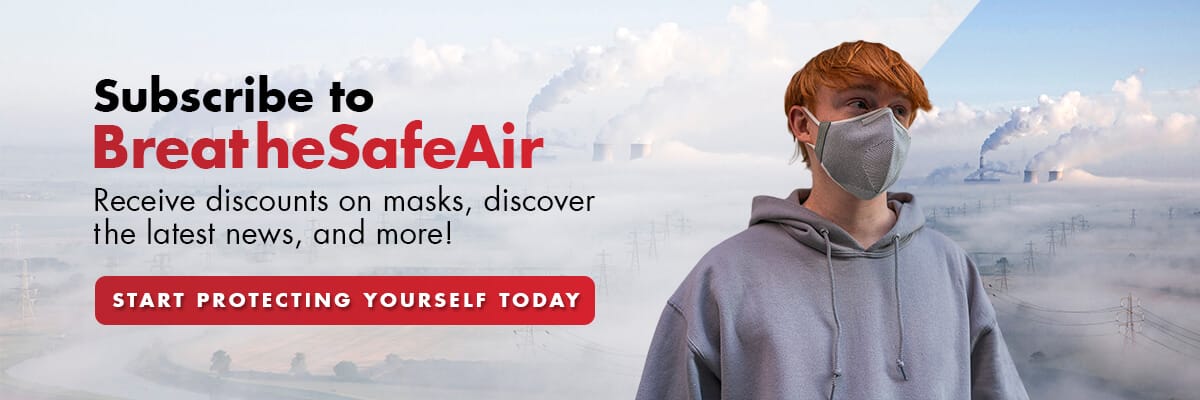
Just letting you know the discount code doesn’t work.
Thanks and kind regards,
Karren.
Hi Karren,
Thank you for letting me know. I’m looking into the issue, hopefully it will be working again soon!
The code works again now. Thank you for letting me know!
What a fantastic site you have created! Thanks so much for the information provided. I’ve ordered the Airweave (the Happy mask wouldn’t ship to Australia). FYI The discount code didn’t work.
Thanks very much !
Thank you, Lisa! I appreciate your saying so 🙂
I’m unsure why the discount code didn’t work but thank you for letting me know. I will look into that!
Hi Ethan, your well-researched, level headed write ups have really opened my eyes to the plethora of masking opportunities around me! Something I struggle to understand is whether this mask is roughly equivalent covid protection-wise to a N95 mask?
Thanks!
Hi Brian,
Thanks for your question! An N95 or equivalent respirator will provide better protection but only due to the superior fit (assuming you can find a well-fitting respirator). Filtration-wise, this AirWeave outperforms most N95 respirators.
I would recommend a mask such as AirWeave for low and medium-risk situations. However, I would still recommend an N95 or equivalent for high-risk situations.
I hope this helps!
Ethan
Great site and information source. I’ve ordered an Airweave to try. The discount code worked. thank you.
Have you trialed Enro (curve) masks?
Hi Wade,
I have not tried Enro masks before – I will look into them now! I’ll let you know if I can put out a review for them shortly.
Thank you!
Hey, thanks for all you’ve done. I just want to delve a little deeper into the recommendation as low risk environment vs high. What would have you recommend it for high risk? A certain certification? If the pfe is equal and the fit is good, why not? Most n95s fail at fit – largely around the nose in real world settings but they would tend to get more recommended for high risk settings due to certifications of filtration. I feel that if the pfe is where it’s supposed to be then the other major factor is fit/seal and this will be more person to person so if the weave happens to fit a person well then for them it would be equally recommended for high risk situations. I’ve personally tried certified kf94s that didn’t have a good seal on me and I would therfore not wear them because I know that the pfe rating isn’t as meaningful at that point.
Thanks
Hi Jason,
Great question! I would have liked a better fit to recommend the mask for high-risk environments. While the mask fits me well, I can feel leaks from time to time, and it’s for these reasons that I don’t recommend it in high-risk settings. Unfortunately, ear-loop masks do not fit as well as head-band respirators such as N95s. As you’ve mentioned, if the mask fits well and performs similarly, the protection provided will be better. However, I wasn’t comparing (and I should have been clear about this) to just any N95; rather, I was comparing to the N95s I normally wear (which do fit me very well).
I guess what I should have said is this – I like the AirWeave for low risk situations, but I would still opt for a well-fitting N95 in high risk situations. I agree that the AirWeave fits better than most KF94s (and therefore will provide more protection), but I find my go-to N95s (3M 1870+ and Honeywell Surgical Respirator) fit better and almost never leak.
I hope this helps to clarify!